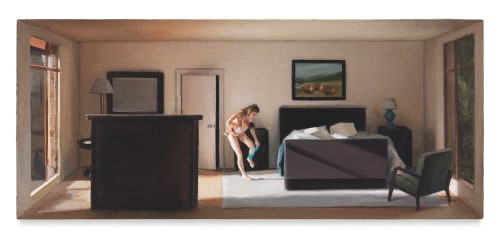
Amy Bennett | The Brooklyn Rail
Review by Robert R. Shane
4 September 2019

Peering into scenes painted on tiny panels, some barely larger than a note card, the viewer observes the intimacy and isolation of Amy Bennett’s one-inch high figures. Their fictional lives, set in richly colored and seemingly idyllic suburban neighborhoods and homes flooded with morning light, are disturbed by marital discontent and parental ambivalence. Family members often inhabit the same rooms, but absorbed in laptops or yoga routines, they never interact; mothers, attentive to their children’s needs, struggle to dress or sleep while infants are latched to their breasts, echoing psychosocial theorist Lisa Baraitser’s claim that the maternal care is “an ethics of interruption.” Although not the central theme in the exhibition, the complexity of motherhood, often eclipsed in the history of art by idealized images of maternity, is one of Bennett’s most important contributions in Nuclear Family, as she illustrates the changing roles mothers play within the “nuclear family” since the term entered popular parlance in the last century.
Bennett’s paintings often show mothers negotiating a new sense of self in lives now governed in large part by the needs of the ones for whom they care. Seated in a wheelchair curbside at the hospital waiting for her husband to pull the car around, the mother of New Mother (2018) stares at her infant in the removable car seat on the sidewalk next to her, as if encountering for the first time the uncanny, absolute otherness of her baby no longer part of her body. In Animals (2018) we look down into a bedroom, its floor parallel and perpendicular to the edges of the panel suggesting a sense of order that contrasts with the chaotic disruption of sleep for the two new parents lying on the bed. As the infant feeds from the breast of the exhausted mother, the bare-chested father lies next to them, present but ineffectual. The dog resting on the floor provides a foil to the infant who is currently the least domesticated creature in the room.
Parallel to women working through new maternal identities, adolescent girls frequently appear in Nuclear Family as they similarly struggle to define themselves during a period of physical and social transformation. In Fashion Show (2018) an adolescent girl models her first two-piece bathing suit in a living room before three generations of seated family members. The orange of her bikini appears nowhere else except within an abstract painting hung above the mantel, suggesting that the girl, with her legs illuminated by window light and face cast in shadow, is being reduced to a passive object for others’ aesthetic consumption. In her body language we sense the embarrassment often felt by adolescent girls, recounted in Simone de Beauvoir’s The Second Sex (1949), as their changing bodies are socially objectified. With only one narrow window, the room in Problem Child (2018) feels like the cell of a convent or prison, a metaphor perhaps for the cultural coercion that de Beauvoir argues makes adolescence a “decisive moment for woman” in which she must renounce her autonomy and sovereignty. Thus, we cannot help but root for the painting’s rebellious protagonist who has ransacked her room and set fire to one corner, our empathy aided by the fact that her back is to the viewer—a device employed in 19th century Romantic painting to signal that the viewer should identify with the subject.
The most recent painting Our Town (2019)—a drone’s-eye-view of a white tent pitched in the wilderness hosting an evening community theatre performance—at first seems anomalous in the exhibition, but it is, in fact, the skeleton key that unlocks the other works. Bennett depicts the final funeral scene from the eponymous 1938 Thornton Wilder play in which performers cast as dead souls sit in chairs facing the audience and receive their newest member, Emily Webb, a mother who has died giving birth to her second child and who in earlier acts we followed through her adolescence and marriage. Wilder’s play is a work of metatheatre: characters interact with invisible props on a setless stage, and a character called “the stage manager” directly addresses the audience; similarly, when in so many of the exhibition’s paintings we are invited to look into rooms missing their fourth wall, we sense the artifice of Bennett’s staged scenes. (As she has done throughout her career, most famously for her aerial views of small towns and countryside in recent years, Bennett painted these works by observing intricate three-dimensional dioramas she constructed.) Yet, most of Wilder’s characters, and all of Bennett’s throughout Nuclear Family, live earnestly, unaware they are being observed or of the scripts directing their lives. Emily realizes life’s vain contrivances only after death, but as omniscient viewers of Bennett’s paintings, we are given the opportunity to reflect now on how our own roles, and those of mothers in particular, may be tacitly scripted.